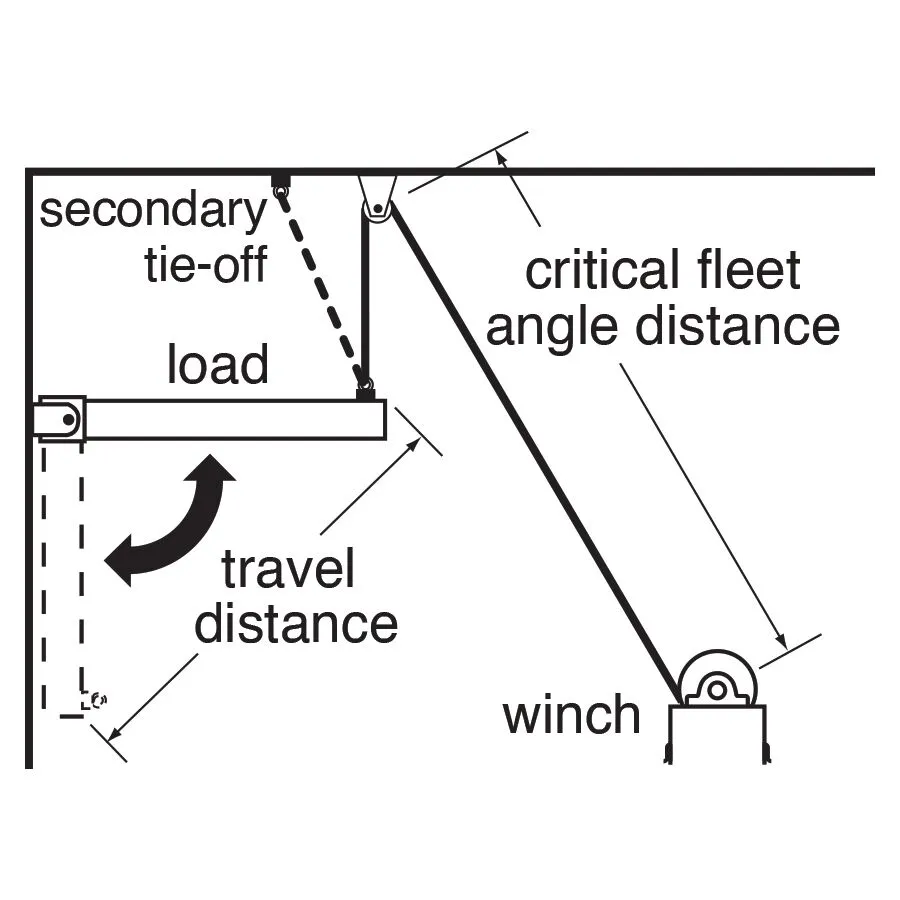Typical Rigging Layouts for Lifting and Hoisting Applications

Floor Mounted
Lifting with Overhead Sheave
- Wire rope passes through overhead sheave to load.
- Brake motor provides load control for lifting.
- Winch is easily accessible for maintenance and operation

Floor Mounted
Lifting with Two-Part Line
- Two-part line decreases load capacity at the winch
- Brake motor provides load control for lifting
- Winch is easily accessible for maintenance and operation.

Floor Mounted
Lifting Hinged Load
- Wire rope passes through overhead sheave to load.
- Brake motor provides load control for lifting.
- Winch is easily accessible for maintenance and operation.

Base Mounted
Positioning Radial Stacker
- Multi-part rigging decreases load capacity at the winch.
- Brake motor provides load control for lifting.
- Winch is easily accessible for maintenance and operation.
Wall Mounted
Lifting with Overhead Sheave
- Wire rope passes through overhead sheave to load.
- Brake motor provides load control for lifting.
- Winch is easily modified for wall mounting.
Ceiling Mounted
Lifting with Two-Part Line
- Wire rope passes through overhead sheave to load.
- Brake motor provides load control for lifting.
- Winch is easily modified for ceiling mounting.
Ceiling Mounted
Lifting Direct to Load
- Load must be free to move side to side or be guided in track.
- Brake motor provides load control for lifting.
- Winch is easily modified for ceiling mounting.
Base Mounted
Positioning Load-Out Chute
- Two winches operate separately to accurately position chute arm.
- Brake motor provides load control for lifting.
- Secondary tie-off secures load when stationary.
Typical Rigging Layouts for Pulling Applications
Floor Mounted
Pulling Cart on Wheels
- Cart is pulled in one direction toward winch.
- Manual clutch allows drum to be disengaged for rapid load hookup
- Cart is guided by tracks or rails to maintain fleet angle.
Mounted In-Line
Single Drum Closed Loop
- Cars can be moved in both directions.
- Both ends of the wire rope are anchored to the same drum.
- Spring sheave maintains tension in wire rope.
Mounted Off-Side
Single Drum Closed Loop
- Cars can be moved in both directions.
- Both ends of the wire rope are anchored to the same drum.
- Spring sheave maintains tension in wire rope.
Mounted Off-Side
Single Drum Closed Loop
- Cars can be moved in both directions.
- Both ends of the wire rope are anchored to the same drum.
- Spring sheave maintains tension in wire rope.
Mounted In-Line
Single Line Pulling Rail Cars
- Rail cars are pulled toward winch, or rope is passed around sheave to reverse direction.
- Manual clutch allows drum to be disengaged for rapid load hookup.
Mounted Off-Side
Closed Loop Pulling Rail Cars
- Cars can be moved in both directions.
- Both ends of the wire rope are anchored to the same drum.
- Spring sheave maintains tension in wire rope.
Mounted Off-Side
Dual Winch Barge Positioning
- Controls operate each winch individually or both of them together.
- Brake motors maintain tension in line to limit drift and deliver quick and accurate positioning.
Mounted Off-Side
Dual Winch Barge Positioning
- Controls operate each winch individually or both of them together.
- Brake motors maintain tension in line to limit drift and deliver quick and accurate positioning.
